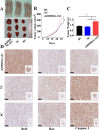Long noncoding RNA DHRS4 antisense RNA 1 suppresses osteosarcoma cell proliferation and promotes apoptosis through a competitive endogenous RNA mechanism
- PMID: 39843945
- PMCID: PMC11754436
- DOI: 10.1038/s41598-025-87246-7
Long noncoding RNA DHRS4 antisense RNA 1 suppresses osteosarcoma cell proliferation and promotes apoptosis through a competitive endogenous RNA mechanism
Abstract
Osteosarcoma (OS) is the most common primary malignant bone tumor. Recent evidence suggests that the novel long noncoding RNA DHRS4 antisense RNA 1 (DHRS4-AS1) serves an important role in cancer progression and metastasis. However, its function and molecular mechanism in OS remain largely unknown. In the present study, DHRS4-AS1 expression was detected in OS cells by quantitative PCR. Gain- and loss-of-function experiments were conducted to study the effects of DHRS4-AS1 on the proliferation and apoptosis of OS cells. The potential mechanism of DHRS4-AS1 was examined through bioinformatics analysis and rescue experiments. DHRS4-AS1 was downregulated in OS cell lines. DHRS4-AS1 depletion promoted proliferation and inhibited apoptosis in OS cells, whereas DHRS4-AS1 overexpression had the opposite effects. Further research suggested that DHRS4-AS1 inhibited OS progression by regulating the microRNA-362-5p/aminopeptidase puromycin sensitive axis. The present findings suggested that DHRS4-AS1 may serve as a potential therapeutic target for OS.
Keywords: DHRS4-AS1; Long noncoding RNAs; MiR-362-5p; NPEPPS; Osteosarcoma.
© 2025. The Author(s).
Conflict of interest statement
Declarations. Competing interests: The authors declare no competing interests. Consent for publication: Not applicable. Ethics approval: The study was approved by the Ethics Committee of the Zhujiang Hospital of Southern Medical University (LAEC-2022-043).
Figures






Similar articles
-
LncRNA TMPO-AS1 serves as a ceRNA to promote osteosarcoma tumorigenesis by regulating miR-199a-5p/WNT7B axis.J Cell Biochem. 2020 Mar;121(3):2284-2293. doi: 10.1002/jcb.29451. Epub 2019 Nov 3. J Cell Biochem. 2020. PMID: 31680323
-
Long non-coding RNA DHRS4 antisense RNA 1 inhibits ectopic endometrial cell proliferation, migration, and invasion in endometriosis by regulating microRNA-139-5p expression.Bioengineered. 2022 Apr;13(4):9792-9804. doi: 10.1080/21655979.2022.2060781. Bioengineered. 2022. PMID: 35414313 Free PMC article.
-
Upregulation of long non-coding RNA NNT-AS1 promotes osteosarcoma progression by inhibiting the tumor suppressive miR-320a.Cancer Biol Ther. 2019;20(4):413-422. doi: 10.1080/15384047.2018.1538612. Epub 2018 Nov 29. Cancer Biol Ther. 2019. PMID: 30489194 Free PMC article.
-
Long noncoding RNA TTN-AS1 enhances the malignant characteristics of osteosarcoma by acting as a competing endogenous RNA on microRNA-376a thereby upregulating dickkopf-1.Aging (Albany NY). 2019 Sep 16;11(18):7678-7693. doi: 10.18632/aging.102280. Epub 2019 Sep 16. Aging (Albany NY). 2019. PMID: 31525734 Free PMC article.
-
Silencing of long noncoding RNA SBF2-AS1 inhibits proliferation, migration and invasion and contributes to apoptosis in osteosarcoma cells by upregulating microRNA-30a to suppress FOXA1 expression.Cell Cycle. 2019 Oct;18(20):2727-2741. doi: 10.1080/15384101.2019.1656478. Epub 2019 Aug 21. Cell Cycle. 2019. Retraction in: Cell Cycle. 2023 May;22(9):1155. doi: 10.1080/15384101.2023.2188820. PMID: 31432728 Free PMC article. Retracted.
Cited by
-
The emerging role of miR-362 in cancer: expression and function across different cancer types.Med Oncol. 2025 Jul 26;42(9):380. doi: 10.1007/s12032-025-02900-4. Med Oncol. 2025. PMID: 40715910 Review.
References
-
- Sadykova, L. R. et al. Epidemiology and risk factors of Osteosarcoma. Cancer Invest.38, 259–269. 10.1080/07357907.2020.1768401 (2020). - PubMed
-
- Chen, C. et al. Immunotherapy for osteosarcoma: fundamental mechanism, rationale, and recent breakthroughs. Cancer Lett.500, 1–10. 10.1016/j.canlet.2020.12.024 (2021). - PubMed
-
- Heymann, M. F., Brown, H. K. & Heymann, D. Drugs in early clinical development for the treatment of osteosarcoma. Expert Opin. Investig. Drugs. 25, 1265–1280. 10.1080/13543784.2016.1237503 (2016). - PubMed
MeSH terms
Substances
Grants and funding
LinkOut - more resources
Full Text Sources
Medical
Miscellaneous

